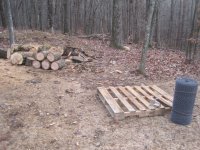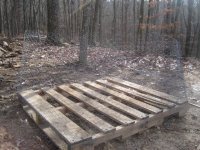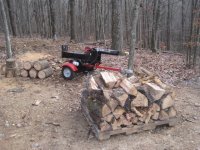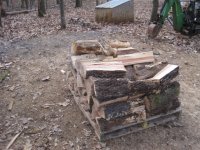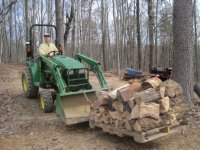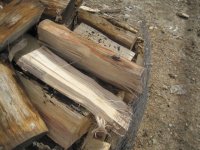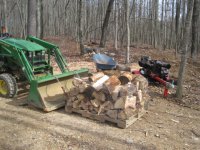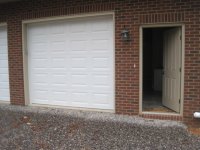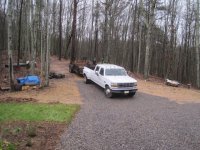Search For the Holy Grail of Firewood Stacking
The
box pallets worked extremely well. I can't imagine a better way to stack and transport firewood at our place. However, we haven't found anymore box pallets. I counted the logs in our log pile. We have over 80 logs, each which is 20+ feet long. That equates to about 120 pallets. It is obvious that the box pallet option will not meet this volume of firewood.
This morning I tried something new. When I told my wife about my idea, she was doubtful. Undaunted, I created a pallet basket using chicken wire that I had lying around. I stapled the wire around the edges of the pallet. I had some loose pieces of chicken wire that were not long enough to reach all the way around the pallet so I spliced some pieces together. When looking at the wire attached to the pallet, I did not like the way the wire looked; it looked as if the top of the chicken wire would just flail outwardly and not support the firewood. So when splicing the pieces together, I made the circumference of the top of the chicken wire a little smaller than the circumference at the bottom of the chicken wire.
At night when I stoke the fireplace before going to bed, I put the 18" pieces in the FP positioned in parallel with the glass FP doors. Then I like to put a short fat log beside the stack of 18" pieces and perpendicular to them. The short fat pieces are about 12" long. However, 12" long pieces of firewood are difficult to stack. It's hard to stack them very high without the stack's falling over.
I had some hickory logs to split so I used them to test my new pallet basket. I stacked the wood in the pallet, without being precise in my stacking. I had purposely cut the logs into two different lengths, 18" and 12". I filled the pallet with all the wood my tractor will reasonably carry. When I picked up the pallet and moved it, the wood in the pallet stayed wonderfully in place. There was no hint of instability in the pallet of wood, even when the tractor was on uneven terrain.
I think I've found a winning solution! This technique will work for any normally sized pallet. The pallets don't all have to be made exactly the same. The materials are extremely cheap. It's reproducible. The pallet baskets are reusable. The wood doesn't need to be carefully stacked. The firewood pieces don't have to be a uniform length. Short pieces of firewood stack just as well as longer pieces.
I can't wait until I get to fill up my next pallet basket!
